Fixed
We specialize in crown and bridge and cosmetic restorations, and are equally adept hand-layering porcelain as using CAD/CAM production to fabricate an all-ceramic solution. We’re comfortable helping our doctors case plan as well as providing consultation to ensure success on every case, and want to be an integral part of your treatment planning process.
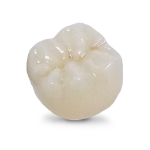
UltraLux Full Zirconia
Designed and fabricated by expert digital dental technicians on our CAD/CAM workflow for the utmost in precision and quick seating, our full-contour zirconia restorations are an ideal option for posterior crowns and bridges. With unsurpassed flexural strengths above 1,300 MPa, zirconia crowns are the most durable restorative option available, while still being gentler on opposing enamel than feldspathic porcelain.
Indicated for posterior crowns, bridges, inlays and onlays. An esthetic solution for bruxers and grinders when PFM metal occlusal/lingual or full-cast restorations are not desired or when patient lacks the preparation space for a PFM or has broken a PFM in the past. Zirconia can also be used for anterior teeth with a facial veneer of porcelain for improved esthetics.
Not ideal for anterior aesthetics, or when bonding is necessary, as bond strength is weaker than other ceramics.
Shoulder preparation not needed, feather edge is okay. It is a conservative preparation similar to full-cast gold, so any preparation with at least 0.5 mm of occlusal space is accepted. Minimum occlusal reduction of 0.5 mm; 1 mm is ideal.
Adjustments and polishing:
Adjust BruxZir® zirconia crowns and bridges using water and air spray to keep the restoration cool and to avoid micro-fractures with a fine grit diamond. If using air only, use the lightest touch possible when making adjustments. A football shaped bur is the most effective for occlusal and lingual surfaces (on anterior teeth); a tapered bur is the ideal choice for buccal and lingual surfaces.
Polish BruxZir® restorations with the porcelain polishing system of your choice.
- Resin Ionomer cement (RelyX or RelyX Unicem, 3M ESPE)
- Maxcem Elite (Kerr)
- Panavia F 2.0 (Kuraray) -ideal for short, tapered preparations
- Glass ionomer cement (GC Fuji, GC America)
| D2740 Crown – Porcelain/Ceramic Substrate <br /> D6245 Pontic Porcelain/Ceramic <br /> D6740 Abutment Crown Porcelain/Ceramic |
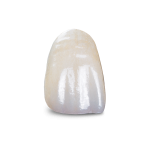
UltraLux Multi-Layered Zirconia
UltraLux Multi-Layered Zirconia offers exceptional benefits for dental restorations, combining strength, aesthetics, and versatility. This advanced material mimics the natural translucency and gradient of real teeth, providing a lifelike appearance that seamlessly blends with surrounding dentition. Its multi-layered structure ensures a gradual color transition from dentin to enamel, enhancing the visual appeal without compromising strength. UltraLux zirconia is highly durable, resistant to chipping and cracking, making it ideal for both anterior and posterior restorations. Additionally, its biocompatibility ensures patient safety and comfort, making it a superior choice for long-lasting, beautiful dental solutions.
Indicated for posterior crowns, bridges, inlays and onlays. An esthetic solution for bruxers and grinders when PFM metal occlusal/lingual or full-cast restorations are not desired or when patient lacks the preparation space for a PFM or has broken a PFM in the past. Zirconia can also be used for anterior teeth with a facial veneer of porcelain for improved esthetics.
Not ideal for anterior aesthetics, or when bonding is necessary, as bond strength is weaker than other ceramics.
Shoulder preparation not needed, feather edge is okay. It is a conservative preparation similar to full-cast gold, so any preparation with at least 0.5 mm of occlusal space is accepted. Minimum occlusal reduction of 0.5 mm; 1 mm is ideal.
Adjustments and polishing:
Adjust BruxZir® zirconia crowns and bridges using water and air spray to keep the restoration cool and to avoid micro-fractures with a fine grit diamond. If using air only, use the lightest touch possible when making adjustments. A football shaped bur is the most effective for occlusal and lingual surfaces (on anterior teeth); a tapered bur is the ideal choice for buccal and lingual surfaces.
Polish BruxZir® restorations with the porcelain polishing system of your choice.
- Resin Ionomer cement (RelyX or RelyX Unicem, 3M ESPE)
- Maxcem Elite (Kerr)
- Panavia F 2.0 (Kuraray) -ideal for short, tapered preparations
- Glass ionomer cement (GC Fuji, GC America)
| D2740 Crown – Porcelain/Ceramic Substrate <br /> D6245 Pontic Porcelain/Ceramic <br /> D6740 Abutment Crown Porcelain/Ceramic |
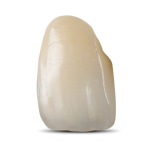
UltraLux Layered Zirconia
Eliminate grey areas at the margin, subgingival discoloration and oxidation associated with alloy based copings with porcelain fused to zirconia crowns. With the esthetics of hand-stacked porcelain layered on a CAD/CAM fabricated zirconia substructure for a digitally precise fit, PFZ crowns from Diamond Dental Laboratory are the perfect marriage of traditional esthetics and modern accuracy.
A CAD/CAM substitute for traditional PFM, our porcelain fused to zirconia can be used for anterior and posterior crowns, crowns over implants and bridges of up to fourteen units.
Should not be used when tooth preparation is not built back up to preparation form or there is over 3 mm of clearance; when adapting to a future or existing partial, or when a metal occlusal is prescribed.
The ideal preparation for a PFZ restoration is a chamfer margin preparation. If a porcelain labial margin is prescribed, then a shoulder margin preparation is required. Feather-edge margin preparations are indicated for full-cast restorations.
- Resin Ionomer cement (RelyX or RelyX Unicem, 3M ESPE)
- Maxcem Elite (Kerr)
- Panavia F 2.0 (Kuraray) -ideal for short, tapered preparations
- Glass ionomer cement (GC Fuji, GC America)
• D2740 Crown
• D2610 Inlay for 1 surface
• D2620 Inlay for 2 surfaces
• D2630 Inlay for 3 surfaces
• D2962 Labial Veneer
• D2783 Crown 3/4 Porcelain Ceramic (does not include veneers)
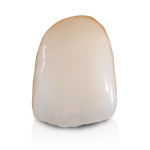
IPS e.max®
The leading high-translucency restoration for more than a decade, IPS e.max® has been the doctors’ choice for a balance of esthetics and strength. Lithium disilicate ceramics offer average flexural strengths of 400 MPa while delivering shading and opacity that’s nearly indistinguishable from natural dentition. Ideal for single unit and bridges of up to three units, IPS e.max is strong enough for nearly any anterior indication.
IPS e.max CAD is indicated for full anterior or posterior crowns. IPS e.max press is indicated for full anterior or posterior crowns and three-unit bridges having only one pontic with the second bicuspid as the most distal abutment. Veneers can also be indicated and are recommended when combining with adjacent IPS e.max crowns or bridges, provided ample reduction is achieved. Otherwise, original IPS Empress or IPS e.max CAD would be indicated for veneers, inlays and onlays.
IPS e.max should not be used on patients with malfunctional occlusion such as bruxers or clenchers. IPS e.max should not be used as abutments for cast partials. IPS e.max should not be used in situations when preparation requirements cannot be achieved. IPS e.max is not indicated for Maryland-type bridges.
Anterior full-coverage crowns require a chamfer or shoulder margin. A circular shoulder is prepared with rounded inner edges or a chamfer at an angle of 10-30°: the width of the shoulder/chamfer is approx. 1 mm. Facial reduction is 1.5 – 2 mm; 1 – 1.5 mm lingual contact clearance. Incisal reduction is 1.5 – 2 mm with rounded internal line angles, and an incisal edge at least 1mm wide to permit optimum milling of the incisal edge during CAD/CAM processing.
Posterior full-coverage crown requires a chamfer or shoulder margin. A circular shoulder is prepared with rounded inner edges or a chamfer at an angle of 10-30°: the width of the shoulder/chamfer is approx. 1 mm. Occlusal reduction is 1.5 – 2 mm: axial reduction (buccal, lingual and interproximal) is 1.5 mm with rounded internal line angles.
For greatest strength, and where preparation allows for dry field (supra-gingiva margins), it is recommended to use adhesive bonding, such as VarioLink II (Ivoclar Vivadent) or similar dual cure materials (Insure, Cosmedent; Nexus, Kerr; Choice, Bisco, Inc.; Lute-It, Pentron).
For areas subgingival, or when a dry field cannot be achieved, Ivoclar Vivadent recommends a hybrid glass ionomer cement system with less than 0.5 percent expansion. (NOTE: Resin-reinforced glass ionomers (Advance, Vitremer) are not indicated for any all-ceramic restoration.)
Some recommended resin cements:
• Vivaglass (Ivoclar Vivadent)
• GC Fuji (GC America)
• Ketec Cem (3M ESPE)
• Panavia F (J. Morita)
• C&B Metabond
• Variolink (Ivoclar Vivadent)
• D2740 Crown
• D2610 Inlay for 1 surface
• D2620 Inlay for 2 surfaces
• D2630 Inlay for 3 surfaces
• D2962 Labial Veneer
• D2783 Crown 3/4 Porcelain Ceramic (does not include veneers)
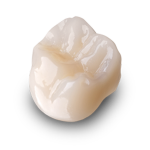
3M™ Lava™
The first name in layered porcelain on zirconia is still the leading name for porcelain fused to zirconia restorations. We digitally design and fabricate a substructure of Lava® zirconia, whose strength allows for conservative preparations to preserve natural dentition. Finished with porcelain layered by experienced ceramists, Lava crowns are an esthetically superior alternative to PFM restorations.
A CAD/CAM substitute for traditional PFM our Lava can be used for anterior and posterior crowns, crowns over implants and bridges of up to fourteen units.
Lava is contraindicated for inlays, onlays and veneers.
The ideal preparation for Lava is a chamfer margin preparation. If a porcelain labial margin is prescribed, then a shoulder margin preparation is required. Feather-edge margin preparations are indicated for full-cast restorations.
- Resin Ionomer cement (RelyX or RelyX Unicem, 3M ESPE)
- Maxcem Elite (Kerr)
- Panavia F 2.0 (Kuraray) -ideal for short, tapered preparations
- Glass ionomer cement (GC Fuji, GC America)
• D2740 Crown
• D2610 Inlay for 1 surface
• D2620 Inlay for 2 surfaces
• D2630 Inlay for 3 surfaces
• D2962 Labial Veneer
• D2783 Crown 3/4 Porcelain Ceramic (does not include veneers)
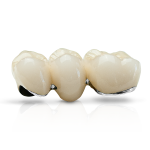
Porcelain Fused to Metal
The most time-tested ceramic restoration, porcelain fused to metal crowns offer the unbeatable strength of an alloy coping and esthetics of feldspathic porcelain. Our wide range of alloy options – nonprecious, semi-precious, white high noble and yellow high noble – provides the flexibility to serve patients regardless of their budgets or insurance reimbursement policies.
PFM restorations are suitable for posterior and anterior restorations when natural teeth have been compromised or have previously been restored, and are ideal for restorations with limited clearance.
Any crown in which less than 2 mm of occlusal clearance is available or for patients with a demonstrated metal sensitifity.
The ideal preparation for PFMs is a chamfer margin preparation. If a porcelain labial margin is prescribed, then a shoulder margin preparation is required.
Feather-edge margin preparations are indicated for full-cast restorations.
• Panavia 21 – tin plated
• Glass ionomer cement (GC Fuji, GC America)
• Zinc Phosphate Polycarboxylate
• Resin Ionomer cement (RelyX, 3M ESPE)
• D2750 Crown Porcelain fused to high noble
• D2751 Crown Porcelain fused to non-precious
• D2752 Crown Porcelain fused to semi-precious
• D6750 Crown Porcelain fused to high noble (bridge units)
• D6751 Crown Porcelain fused to non-precious (bridge units)
• D6752 Crown Porcelain fused to semi-precious (bridge units).
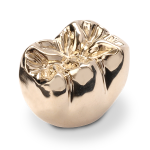
Full Cast Crown
When structural strength or biocompatibility are critical, full cast crowns remain the dentists’ choice. Cast by veteran technicians with extensive experience working with alloy, full-cast crowns are more resistant to plaque and bacteria than other materials. Every full-cast case we ship is accompanied by a an IdentAlloy sticker identifying its composition, manufacturer, brand name and standard symbol for proper insurance billing.
Full-cast crowns are suitable for posterior restorations and long-span bridges. It’s an ideal option for restorations with minimal occlusal clearance or sort occluso-gingival height
Crowns when caries extend gingivally, anterior restorations or in patients with uncontrolled caries
Inlays and onlays can also be fabricated as a full-cast restoration.
Feather-edge margin preparations are indicated for full-cast restorations, but any margin preparation may be used.
• Panavia 21 (Must be tinplated if precious metal is used)
• Glass ionomer cement (GC Fuji, GC America)
• Zinc Phosphate Polycarboxylate Resin Ionomer cement (RelyX, 3M ESPE)
• D2790 Crown Full-Cast Hi-Noble Metal
• D2791 Crown Full-Cast Predominantly Base Metal
• D2792 Crown Full-Cast Noble Metal
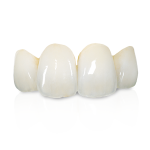
UltraLux PMMA
Fabricated using the same design files we use when crafting a permanent restoration, Crystal Temporaries offer patients the opportunity to try in and ensure occlusion matches and seating is acceptable. Milled from durable PMMA, temporaries offer patients the comfort and confidence to smile as surgeries heal.
Crystal temporaries are indicated for provisional splinted crowns and bridges. For a bridge with pontic span greater than three units, a cast-metal substructure may be necessary. Crystal temporaries may be used provisionally over anterior extractions.>
Crystal Temporaries are not indicated for restorations placed longer than six months.
No additional preparation is required beyond that needed to prepare for the final restoration.
Use any temporary cement to affix Crystal Temporaries.
• D2740 Crown

